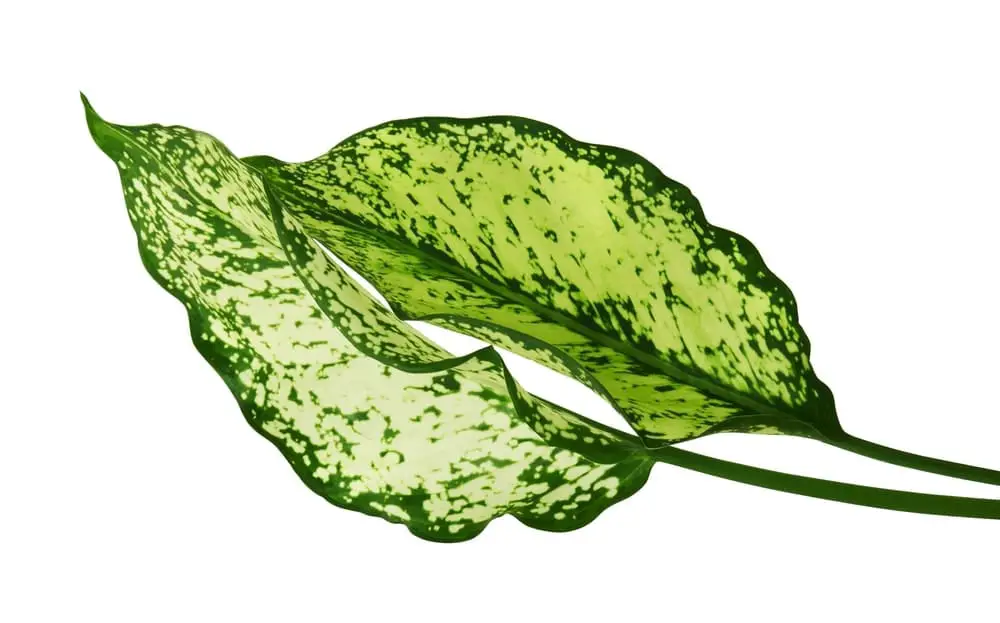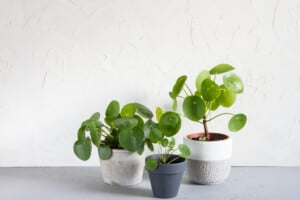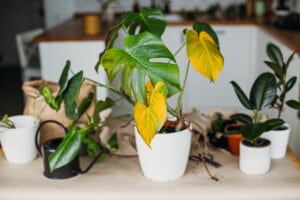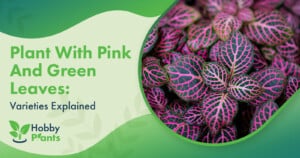The Aglaonema plant is also known as the Chinese Evergreen. There are many varieties of it, including Cutlass, Indo Princess, Pink Splash, Pink Dalmatian, Red, Silver Bay, and Spring Snow.
Each variety is well known for its bright and unique color patterns, making it a beautiful and common choice for a houseplant.
The Aglaonema Plant
The Aglaonema plant is native to Asia and New Guinea, specifically both tropical and subtropical regions. These plants are rising in popularity as houseplants due to the minimal level of work required to maintain them. Aglaonema thrives in low light, but many varieties are well suited and adaptable to all levels of light. In addition, the Aglaonema has been known to do well in both moist and dry conditions. Because of these factors, the Aglaonema is perfect for someone who is too busy to frequently tend their houseplants, or who is forgetful when it comes to watering.
Perfectly suited for low-light bedrooms or offices, the Aglaonema have large, narrow, glossy leaves with short stems. The leaves come in a variety of colors and patterns based on the specific type of Aglaonema, as there are many different types of Aglaonema. However, care for each species is relatively the same, as all are fairly low maintenance and can appreciate a variety of conditions. Aglaonema are also excellent air purifiers, making them a very healthy choice for the home.
Why Aglaonema Plants Gets Yellow Leaves
The Aglaonema plant can suffer from several conditions that may yellow and/or curl the leaves.
1. Moisture
In most houseplants, the most common cause of yellowing leaves is incorrect moisture level. Be careful of overwatering your aglaonema! Aglaonema does not need much water, but can also suffer from dehydration if it is not watered enough. It’s also important to maintain consistency when watering, as going from very dry soil to very wet soil will cause the plant stress. And when you do water your Aglaonema, make sure that the water is draining correctly, and that you do not let water sit in the bottom of the pot, as this can cause root rot.
2. Humidity
Leaves may brown on the edges and then fully turn yellow if the humidity is too low or the soil is too dry. Humidity is something that many forget to take into account.
3. Light
The aglaonema does not like direct sunlight. Beware putting your aglaonema near a window or in a direct sunbeam, as too much light can cause the leaves to burn. Aglaonema does best in low or indirect sunlight. It can adapt to medium sunlight, and many specific types of aglaonema have been known to do well in a variety of sun levels, but that will depend on the specific type of aglaonema you have.
4. Pests
Pests such as Scale, Mealybugs, and Spidermites are common problems for indoor plants, including the Aglaonema. Spidermites are sap suckling pests, and are often responsible for draining moisture from houseplants. An aglaonema that is weakened by overwatering, too much light, or conditions that are not ideal will be more susceptible to pests, as it will be more difficult for the plant to fight them off. Pests should be eradicated quickly, because if the issue is left unchecked, they may spread further into the plant, and even onto other houseplants.

Treatments
Moisture
- When you water your aglaonema, pour water until the water flows from the drainage holes at the bottom of the plant. This means it has had enough water. Empty the saucer when this happens. If your aglaonema is not draining properly, it may need to be repotted.
- Make sure your aglaonema is never standing in water, as this can cause root rot.
- Your aglaonema does not need to be watered frequently. Only water when the top 2”-3” of soil are dry.
- Soil should remain damp, but not wet. If your plant is too wet, try repotting.
- Aglaonema does not need to be watered as much in the winter.
Humidity
- Aglaonema likes humidity. If your air or soil is too dry, try misting with a water bottle.
- A humidifier may also help.
Light
- Direct sunlight or too much sunlight can burn Aglaonema’s leaves and cause them to yellow or brown.
- If your aglaonema is getting too much light, try putting it in a dark corner, or just relocating in general to a less sunny spot.
Pests
- If your aglaonema is infested with spider mites, try cleaning with a solution of 1 part alcohol to 1 part water. If your plant is already weakened from other issues, adjust the solution to be 1 part alcohol to 3 parts water. A dish soap and water solution may also work. In this case, combine 1 teaspoon of dish soap with 1 liter of water. Either spray this on the infected plant using a spray bottle, or wash the plant with a cloth or sponge.
- Prevent spider mites on your plants by inspecting often, so that you may act at the first sign of infestation. Plants that have taken too much damage from mites may not recover, and it is better to dispose of them, rather than risk them spreading to the rest of your houseplants.
How to Take Care of the Yellow Leaves
To remove yellow leaves from your aglaonema, make angled cuts just below the yellow area. If the yellow leaves turn brown, cut foliage back even more, even all the way to the soil.
Conclusion
The Aglaonema is a very low maintenance plant, making it a good fit for those who are forgetful, busy, or not especially mindful. However, if the leaves of your aglaonema begin to yellow, that may be a sign that something is wrong with the moisture level, humidity, sunlight, or it could indicate the presence of pests such as spider mites.
As long as your water your aglaonema regularly but not too often, routinely check for pests, place it somewhere with low, indirect sunlight, and maintain the proper levels of humidity, your plant should do fine.
Victoria is the owner and main author of hobby plants. She loves spending her free time in her garden planting and taking care of her plants. Victoria hopes you enjoy the content here!


![Why Are My Orchid Leaves Turning Yellow? [Find Out Here] Why Are My Orchid Leaves Turning Yellow? [Find Out Here]](https://www.hobbyplants.com/wp-content/uploads/2022/07/orchid-leaves-turning-yellow-300x158.jpg)

![Why Is My Bamboo Plant Turning Yellow? [Find Out Here] Why Is My Bamboo Plant Turning Yellow? [Find Out Here]](https://www.hobbyplants.com/wp-content/uploads/2022/07/why-is-my-bamboo-turning-yellow-300x158.jpg)
![Why Is My Fiddle Leaf Fig Dropping Leaves? [ANSWERED] Why Is My Fiddle Leaf Fig Dropping Leaves? [ANSWERED]](https://www.hobbyplants.com/wp-content/uploads/2022/06/why-is-my-fiddle-leaf-fig-dropping-leaves-300x158.jpg)
![Why Are My Bird of Paradise Leaves Curling? [FIND OUT HERE] Why Are My Bird of Paradise Leaves Curling? [FIND OUT HERE]](https://www.hobbyplants.com/wp-content/uploads/2022/07/bird-of-paradise-leaves-curling-300x158.jpg)
![Why Are My Peace Lily Leaves Turning Brown? [EXPLAINED] Why Are My Peace Lily Leaves Turning Brown? [EXPLAINED]](https://www.hobbyplants.com/wp-content/uploads/2022/07/peace-lily-leaves-turning-brown-1-300x158.jpg)
